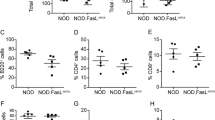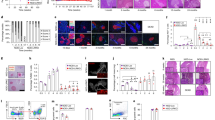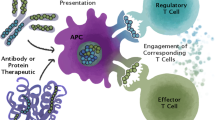Abstract
Type I diabetes is the result of a selective destruction of insulin-producing β cells in pancreatic islets by autoreactive T cells. Depletion of autoreactive T cells through apoptosis may be a potential strategy for the prevention of autoimmune diabetes. Simultaneous stimulation of the Fas-mediated pathway and blockade of costimulation by a CTLA4-Fas ligand (FasL) fusion protein has been reported to lead to enhanced in vitro apoptosis of peripheral lymphocytes. To test the feasibility of CTLA4-FasL-based gene therapy to prevent autoimmune diabetes, we developed a recombinant adenovirus containing the human CTLA4-FasL gene (AdCTLA4-FasL). A single injection of 2 × 108 plaque-forming units of AdCTLA4-FasL via the tail vein of mice greatly reduced the incidence of autoimmune diabetes (13%, n=15) induced by multiple low-dose streptozotocin. AdCTLA4-FasL administration abrogated pancreatic insulitis, significantly increased apoptosis of pancreatic T-lymphocytes, and altered splenocyte response to mitogenic and antigenic stimulation. These results indicate the therapeutic potential of simultaneous stimulation of the Fas-mediated pathway and blockade of costimulation by adenovirus-mediated CTLA4-FasL gene transfer in the prevention of autoimmune diabetes.
This is a preview of subscription content, access via your institution
Access options
Subscribe to this journal
Receive 12 print issues and online access
$259.00 per year
only $21.58 per issue
Buy this article
- Purchase on Springer Link
- Instant access to full article PDF
Prices may be subject to local taxes which are calculated during checkout








Similar content being viewed by others
References
Atkinson MA, MacLaren NK . The pathogenesis of insulin-dependent diabetes mellitus. N Engl J Med 1994; 331: 1428–1436.
Paik SG, Fleischer N, Shin S . Insulin-dependent diabetes mellitus induced by subdiabetogenic doses of streptozotocin: obligatory role of cell-mediated autoimmune processes. Proc Natl Acad Sci USA 1980; 77: 6129–6133.
Rossini AA et al. Complete protection from streptozotocin-induced diabetes in mice. Nature (Lond) 1978; 276: 182–184.
Herold KC, Montag AG, Fitch FW . Treatment with anti-lymphocyte antibodies prevents induction of insulitis in mice given multiple doses of streptozotocin. Diabetes 1987; 36: 796–801.
Van Parijs L Abbas AK . Homeostasis and self-tolerance in the immune system: turning lymphocytes off. Science 1998; 280: 243–248.
Nagata S . Fas ligand-induced apoptosis. Annu Rev Genet 1999; 33: 29–55.
Dharnidharka VR et al. Fas stimulation results in selective islet infiltrate apoptosis in situ and reversal of diabetes. Ann N Y Acad Sci 2002; 958: 160–162.
Kim S et al. Inhibition of autoimmune diabetes by Fas ligand: the paradox is solved. J Immunol 2000; 164: 2931–2936.
Ogasawara J et al. Lethal effect of the anti-Fas antibody in mice. Nature 1993; 364: 806–809.
Tanaka M et al. Lethal effect of recombinant human Fas ligand in mice pretreated with Propionibacterium acnes. J Immunol 1997; 158: 2303–2309.
Matsue H et al. Induction of antigen-specific immunosuppression by CD95L cDNA-transfected ‘killer’ dendritic cells. Nat Med 1999; 5: 930–937.
Bulfone-Paus S et al. An interleukin-2-IgG-Fas ligand fusion protein suppresses delayed-type hypersensitivity in mice by triggering apoptosis in activated T cells as a novel strategy for immunosuppression. Transplantation 2000; 69: 1386–1391.
Oschilewski M et al. Administration of silica or monoclonal antibody to Thy-1 prevents low-dose streptozotocin-induced diabetes in mice. Immunol Lett 1986; 12: 289–294.
Castano L, Eisenbarth GS . Type-I diabetes: a chronic autoimmune disease of human, mouse, and rat. Annu Rev Immunol 1990; 8: 647–679.
Baliga P et al. CTLA4Ig prolongs allograft survival while suppressing cell-mediated immunity. Transplantation 1994; 58: 1082–1090.
Lin H et al. Long-term acceptance of major histocompatibility complex mismatched cardiac allografts induced by CTLA4-Ig plus donor-specific transfusion. J Exp Med 1993; 178: 1801–1806.
Finck BK, Linsley PS, Wofsy D . Treatment of murine lupus with CTLA4Ig. Science 1994; 265: 1225–1227.
Lu L et al. Fas ligand (CD95L) and B7 expression on dendritic cells provide counter-regulatory signals for T cell survival and proliferation. J Immunol 1997; 158: 5676–5684.
Huang JH, Tykocinski ML . CTLA-4-Fas ligand functions as a trans signal converter protein in bridging antigen-presenting cells and T cells. Int Immunol 2001; 13: 529–539.
Elhalel MD et al. CTLA-4. FasL induces alloantigen-specific hyporesponsiveness. J Immunol 2003; 170: 5842–5850.
Bramson JL, Graham FL, Gauldie J . The use of adenoviral vectors for gene therapy and gene transfer in vivo. Curr Opin Biotechnol 1995; 6: 590–595.
Kolls J et al. Prolonged and effective blockade of tumor necrosis factor activity through adenovirus-mediated gene transfer. Proc Natl Acad Sci USA 1994; 91: 215–219.
Apparailly F et al. Adenovirus-mediated transfer of viral IL-10 gene inhibits murine collagen-induced arthritis. J Immunol 1998; 160: 5213–5220.
Le CH et al. Suppression of collagen-induced arthritis through adenovirus-mediated transfer of a modified tumor necrosis factor a receptor gene. Arthritis Rheum 1997; 40: 1662–1669.
Ma Y et al. Inhibition of collagen-induced arthritis in mice by viral IL-10 gene transfer. J Immunol 1998; 161: 1516–1524.
Buschard K, Rygaard J . Passive transfer of streptozotocin induced diabetes mellitus with spleen cells. Studies of synogeneic and allogeneic transfer to normal and athymic nude mice. Acta Pathol Microbiol Scand 1977; 85: 469–472.
Russell WC . Update on adenovirus and its vectors. J Gen Virol 2000; 81: 2573–2604.
Lenschow DJ et al. Differential effects of anti-B7-1 and anti-B7-2 monoclonal antibody treatment on the development of diabetes in the nonobese diabetic mouse. J Exp Med 1995; 181: 1145–1155.
Chervonsky AV et al. The role of Fas in autoimmune diabetes. Cell 1997; 89: 17–24.
Lenardo M et al. Mature T lymphocyte apoptosis–immune regulation in a dynamic and unpredictable antigenic environment. Annu Rev Immunol 1999; 17: 221–253.
Kang SM et al. Fas ligand expression in islets of Langerhans does not confer immune privilege and instead targets them for rapid destruction. Nat Med 1997; 3: 738–743.
Gainer AL et al. Improved survival of biolistically transfected mouse islet allografts expressing CTLA4-Ig or soluble Fas ligand. Transplantation 1998; 66: 194–199.
Lau HT et al. Prevention of islet allograft rejection with engineered myoblasts expressing FasL in mice. Science 1996; 273: 109–112.
Takeda Y et al. Protection of islet allografts transplanted together with Fas ligand expressing testicular allografts. Diabetologia 1998; 41: 315–321.
Stosic-Grujicic S et al. Antidiabetogenic effect of pentoxifylline is associated with systemic and target tissue modulation of cytokines and nitric oxide production. J Autoimmun 2001; 16: 47–58.
He TC et al. A simplified system for generating recombinant adenoviruses. Proc Natl Acad Sci USA 1998; 95: 2509–2514.
Jin Y et al. Simultaneous administration of a low-dose mixture of donor bone marrow cells and splenocytes plus adenovirus containing CTLA4Ig gene result in stable mixed chimerism and long-term survival of cardiac allograft in rat. Immunology 2003; 110: 275–286.
Like AA, Rossini AA . Streptozotocin-induced pancreatic insulitis: new model of diabetes mellitus. Science 1976; 193: 415–417.
Herold KC et al. Regulation of cytokine production during development of autoimmune diabetes induced with multiple low doses of streptozotocin. J Immunol 1996; 156: 3521–3527.
Bryan RG et al. Effect of CD28 signal transduction on c-Rel in human peripheral blood T cells. Mol Cell Biol 1994; 14: 7933–7942.
Acknowledgements
This work was supported by a grant, 39830340, from the National Natural Science Foundation of China. We wish to express our gratitude to S Nagata of the Osaka University Medical School, JF Elliott of the University of Alberta, Canada, and Tong-chuan He of the Howard Hughes Medical Institute for their gifts.
Author information
Authors and Affiliations
Rights and permissions
About this article
Cite this article
Jin, Y., Qu, A., Wang, G. et al. Simultaneous stimulation of Fas-mediated apoptosis and blockade of costimulation prevent autoimmune diabetes in mice induced by multiple low-dose streptozotocin. Gene Ther 11, 982–991 (2004). https://doi.org/10.1038/sj.gt.3302260
Received:
Accepted:
Published:
Issue Date:
DOI: https://doi.org/10.1038/sj.gt.3302260
Keywords
This article is cited by
-
Targeting the B7 Family of Co-Stimulatory Molecules
BioDrugs (2013)
-
Prolongation of corneal allograft survival by CTLA4-FasL in a murine model
Graefe's Archive for Clinical and Experimental Ophthalmology (2007)
-
Gene Therapy Progress and Prospects: Gene therapy for diabetes mellitus
Gene Therapy (2005)
-
Transplanted islets from lpr mice are resistantto autoimmune destruction in a model of streptozotocin-induced type I diabetes
Apoptosis (2005)



